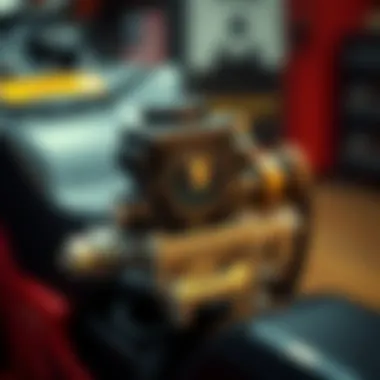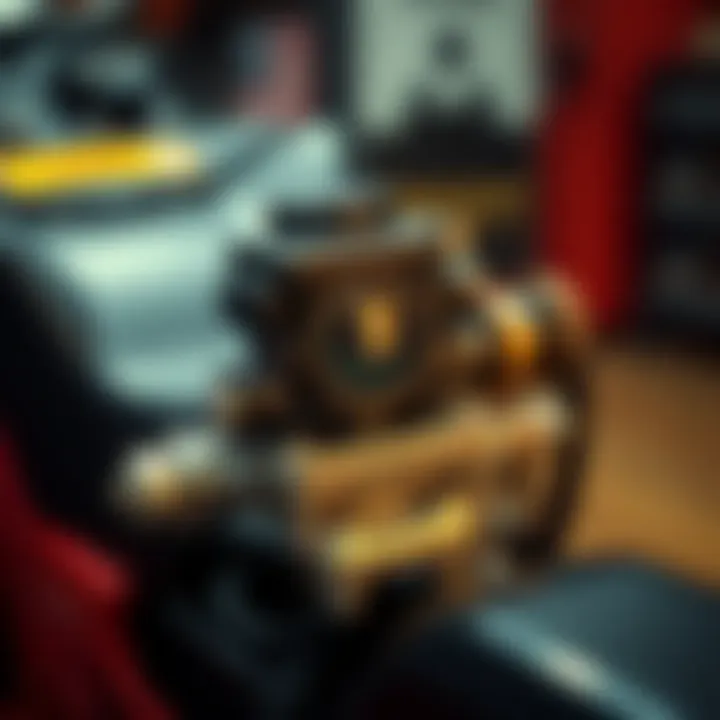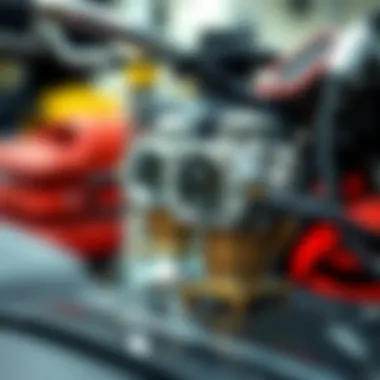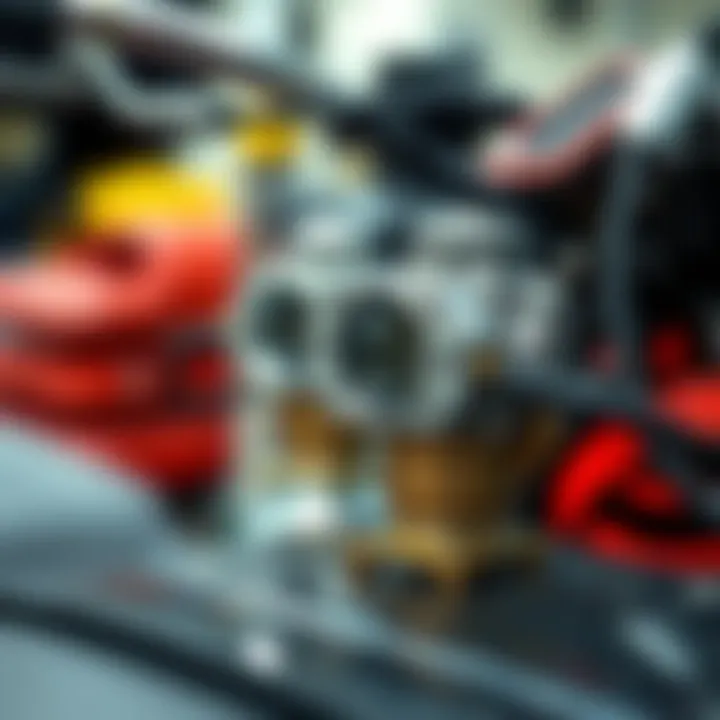Exploring the Arctic Cat 90cc Carburetor Functionality


Intro
The Arctic Cat 90cc carburetor represents a cornerstone in the performance of youth ATVs, particularly those designed for smaller riders. Understanding its functionality, maintenance, and potential issues is critical for anyone wanting to enhance their riding experience. In this article, we will break down the architecture of the carburetor, explore common challenges faced by users, and discuss the various avenues for repair and modification. This exploration not only benefits the recreational user but also appeals to mechanics and enthusiasts seeking to leverage optimal performance from the ATV.
Market Research Overview
The ATV market, particularly in the youth segment, is evolving rapidly, driven by consumer demand for more power, efficiency, and safety features. The Arctic Cat 90cc carburetor is a vital component contributing to these advancements. Knowing market trends and consumer preferences gives valuable insight into how these carburetors can be tailored to meet needs better.
Industry Trends and Insights
In recent years, there has been an uptick in the popularity of entry-level ATVs, especially among teens and younger riders. Factors such as safety, ease of use, and reliability are at the forefront of consumers' minds when selecting vehicles. The Arctic Cat 90cc caters to this demographic with its compact design and accessible power delivery.
Features that are gaining traction include:
- Fuel Efficiency: Modern carburetors are designed to optimize fuel usage, leading to longer ride times, which is a significant consideration for parents.
- Adjustability: Users are increasingly interested in carburetors that allow for easy tuning, enabling them to match performance with rider skill levels.
- Durability: As the terrain varies, consumers prefer parts that are robust against wear and tear, which is crucial for longevity.
Consumer Demographics
The typical user demographic for the Arctic Cat 90cc primarily consists of young riders aged between 10 and 16 years, often supervised by parents who ensure safe riding practices. In addition to younger riders:
- Family-oriented consumers tend to look for reliable machines that can accommodate multiple family members.
- Enthusiasts and mechanics who enjoy tinkering will often purchase these carburetors for customization or repair purposes.
The insights derived from the above trends showcase a strong inclination towards efficient, customizable, and durable components such as the Arctic Cat 90cc carburetor. This not only aids in attracting new customers but also fosters brand loyalty among experienced riders who appreciate quality and performance.
Reviews and Ratings
Consumer insights and expert opinions are invaluable when navigating the market of ATV components, and the Arctic Cat 90cc carburetor is no exception. Examining user reviews and ratings helps prospective buyers understand the real-world functionality of the item.
Detailed Product Breakdown
- Design: The carburetor features an intuitive layout that makes it user-friendly for maintenance and adjustments.
- Performance: Riders frequently report smooth throttle response and enhanced acceleration.
- Maintenance: While some users encounter challenges regarding jetting, the overall consensus is that it is manageable and worth the effort for optimizing performance.
Expert Review Summaries
Experts in automotive performance consistently recognize the Arctic Cat 90cc carburetor for its balance of affordability and functionality. While debates may arise regarding aftermarket options, many agree that stock performance serves adequately for the vehicle’s intended purpose. Here’s what some reviews indicate:
"For mixed terrain performance as well as reliability, the Arctic Cat 90cc carburetor holds its own against competitors. Fine tuning really brings out the best in it, making the ride more enjoyable and safer for younger riders."
Overall, the consensus is that this carburetor strikes the right chords with its design and user-friendliness, making it a go-to choice among young ATVers and their families.
Epilogue
Understanding the Arctic Cat 90cc carburetor goes beyond mere operation; it's about enhancing the entire ATV experience. With the right maintenance, addressing common issues, and being aware of aftermarket modifications, users can maximize their vehicle's performance. This comprehensive examination not only provides practical knowledge but also encourages engagement with the broader ATV community.
For more information, visit:
- Wikipedia - Carburetor
- Britannica - All-Terrain Vehicle
- Reddit - ATV Community
- Facebook - Arctic Cat Group
- GOV - ATV Safety
- EDU - ATV Use and Safety
Understanding the Role of the Carburetor
The carburetor occupies a pivotal place in the functioning of the Arctic Cat 90cc ATV. It acts as the bridge that connects the fuel system with the engine's operation, ensuring that the right mix of air and fuel reaches the engine at all times. This balance is crucial, as an inadequately tuned carburetor can lead to performance inefficiencies, hinder fuel economy, or even cause significant engine damage over time.
Mechanics of Fuel Delivery
At the heart of any carburetor’s function is its ability to deliver fuel in a finely-tuned manner. This involves creating a vacuum that draws fuel from the float chamber into the airflow that enters the engine. There’s a fine interplay between pressure and flow, which dictates how effectively fuel combusts when mixed with air.
When the throttle opens, the engine inhaling air reduces pressure in the carburetor. As the pressure drops, fuel flows from the main jet, atomizing and mixing into the incoming air. This process is where the nuances of design truly shine—the size of jets, the shape of the venturi, even the temperature of the air can influence this delicate dance.
In simpler terms, if there’s too much fuel, you’ll get a rich mixture, leading to sluggish performance and black smoke. Conversely, a lean mixture can choke the engine, causing it to stall or misfire. Thus, the mechanics of fuel delivery are not just about movement but rather precise engineering that optimizes efficiency.
Significance in Engine Operation
The significance of the carburetor stretches beyond just delivering fuel. It plays a key role in the overall efficiency and responsiveness of the Arctic Cat 90cc engine. Proper carburetor function ensures that the throttle response is sharp and that the vehicle can accelerate smoothly, whether you’re navigating through rocky terrain or cruising along flat paths.
Moreover, it helps maintain optimal engine temperature by ensuring a smooth combustion process. A well-tuned carburetor can lead to better fuel economy and reduced emissions—a win-win for the user and the environment. Keeping the carburetor in top shape means your ATV won’t just perform well; it’ll also be more reliable over the long haul.
In summary, understanding the role of the carburetor is fundamental for any Arctic Cat 90cc owner. This knowledge empowers riders to make informed decisions about maintenance and upgrades, contributing to longevity and performance of their prized ATVs. Ensuring that it operates correctly can significantly impact both the reliability and enjoyment of the ride.
Overview of the Arctic Cat 90cc Model
The Arctic Cat 90cc ATV model stands as an iconic representation of youth-friendly all-terrain vehicles, boasting a blend of performance and safety features that make it suitable for young riders. Understanding this model is crucial, as it serves as the foundation for many ATV enthusiasts looking to engage with off-road adventures.
Specifications and Features
The Arctic Cat 90cc combines both power and agility, featuring a robust engine that delivers an exhilarating ride without overwhelming inexperienced riders. Here are some specifications that make it a noteworthy model:
- Engine Type: Air-cooled, single-cylinder, two-stroke engine
- Displacement: 90cc, which strikes a balance between power and manageability
- Transmission: Automatic with a centrifugal clutch for ease of use
- Brakes: Front and rear hydraulic disc brakes, providing reliable stopping power
- Seat Height: A comfortable height suitable for younger riders, enhancing control and comfort
- Weight: Lightweight frame allows for better maneuverability
These specifications highlight a vehicle designed for both new and young riders. Its manageable size and features create an ideal learning platform, encouraging a safe introduction to the world of ATV riding.
Target Audience and Usage
The Arctic Cat 90cc ATV primarily targets children and adolescents, serving as an entry point into the exhilarating realm of outdoor motorsports. Parents often look for models like this one that provide a safe environment for learning the essentials of riding.
This model is perfect for:
- Young Riders: Usually between the ages of 10 to 14, ready to learn basic riding skills in a controlled manner.
- Families: It allows parents to enjoy outdoor activities together with their children.
- Outdoor Enthusiasts: Those looking to explore trails or fields without too much exertion.
Given its balance of power and safety, the Arctic Cat 90cc is ideal for family outings and adventures, creating memorable experiences while ensuring that everyone has fun in a safe setting. The ease of use and low maintenance demands also make this model a favorite for parents who want to encourage safe outdoor exploration without the constant concerns of performance issues.
Design and Components of the Carburetor
The design and components of the carburetor in the Arctic Cat 90cc play a pivotal role in how effectively the engine performs. They directly influence fuel efficiency, throttle response, and overall driving experience. Understanding these components helps enthusiasts and operators make informed decisions about maintenance and potential upgrades. The carburetor isn’t just a mere accessory; it’s the heart of the fuel system, ensuring the right mix of air and fuel to keep the engine running smoothly.
Structural Elements and Materials
A carburetor's structure is comprised of several elements that work in harmony to optimize fuel delivery. Key components include the float chamber, jetting systems, and the throttle plate. The float chamber, usually made from a durable plastic or metal, regulates the fuel flow by maintaining a certain level within the chamber. This ensures there’s always enough fuel available for the jets.
The jets, typically brass, are calibrated to allow a specific amount of fuel through, determined by various factors including altitude and temperature. It’s essential that these are clean and properly fitted, as blockages can lead to inefficient fuel delivery or even engine failure.
The throttle plate controls the airflow into the engine. When the rider accelerates, this component opens wider, allowing more air to mix with fuel. Made of aluminum or plastic, it requires precise adjustment to maintain responsiveness during operation. If it’s poorly calibrated, it could affect the entire performance of the ATV.


In addition to functionality, materials are chosen not just for performance but also durability against environmental factors, and wear from fuel. Modern carburetors often incorporate composite materials that resist corrosion, ensuring longevity even in harsh conditions. Having a thorough understanding of these structural elements will aid users in recognizing when parts need attention or replacement, ultimately influencing their riding experience.
Fluid Dynamics in Carburetor Function
Understanding fluid dynamics in the carburetor's operation is critical. At its core, a carburetor depends on the principle of creating a vacuum to draw fuel into the airstream. When the throttle plate opens, a drop in pressure occurs in the venturi tube, which is a narrowed portion of the carburetor.
As air rushes through this narrowed section, the velocity increases, and pressure drops. This results in a phenomenon commonly referred to as the Bernoulli principle. Due to this pressure differential, fuel is drawn through the jets into the airflow, creating an effective mist that combines with the incoming air, leading to a finely tuned fuel-air mixture.
- Factors affecting fluid dynamics include:
- The size of the jets: Larger jets allow more fuel but can lead to richness, whereas smaller jets limit flow, leading to lean conditions.
- Throttle response: How quickly the throttle plate reacts affects the immediate air and fuel mixture, impacting acceleration and overall performance.
Balancing these dynamics is crucial. If the mixture leans too far toward air, it can cause knocking and engine strain; too rich, and you'll face performance issues and increased emissions. For that reason, regular checks and tuning can help maintain optimal fluid flow, supporting both performance and engine health.
"A well-tuned carburetor transforms an ordinary ride into an extraordinary experience; this balance between air and fuel is the key to a rip-roaring adventure on the Arctic Cat 90cc."
Common Issues with the Arctic Cat 90cc Carburetor
Understanding the potential setbacks of the Arctic Cat 90cc carburetor is essential for optimal operation. Being aware of common issues can prevent frustrations down the line and ensure a smoother ride. This section will cast a light on two fundamental aspects: how to spot symptoms of malfunction and the underlying causes of these issues. Each section will delve into particularities, helping enthusiasts confront engine troubles head-on.
Symptoms of Malfunction
Identifying symptoms is the first step in troubleshooting. Some indicators might be subtle, while others hit like a freight train. Here are key signs to keep an eye on:
- Engine Won't Start: If your ATV refuses to come to life, the carburetor might be at fault. This can be due to the proper fuel-air mix being off.
- Stalling: Sudden stalling during rides could signify fuel starvation or flooding issues. Listen for that engine dying mid-action— it’s a telltale sign.
- Poor Acceleration: If a thrilling burst of speed feels more like molasses, issues with carburetor jetting or clogged passages might be causing this drag.
- Backfiring: Unusual sounds like backfire often signal a lean fuel mixture, suggesting that something in the carburetor isn't performing as it should.
- Rough Idle: Is your ride vibrating or sputtering while idling? This could mean your carburetor settings are out of whack.
Realizing these symptoms early could save time and effort, allowing for prompt intervention and repairs.
Root Causes of Problems
Now that you've diagnosed some issues, the next step is to understand what is causing these headaches. Recognizing the root causes can aid in avoiding these pitfalls in the future.
- Clogged Jets: Over time, debris can build up in the jets, causing poor fuel flow. Regular cleaning is essential here.
- Old Fuel: Fuel that sits for extended periods breaks down, leading to varnish build-up that can block fuel lines and jets.
- Improper Adjustments: Carburetors need fine-tuning. An improper air-fuel mix can stem from careless adjustments during maintenance.
- Vacuum Leaks: Leaks in the intake system can result in false air entering the engine, throwing off the delicate balance between air and fuel.
- Wear and Tear: Like many components, carburetors can suffer from wear over time. Gaskets and seals can degrade, allowing unmonitored fuel flow, which impacts performance.
Keeping these factors in mind ensures a deeper understanding of what might be lurking beneath the surface of your Arctic Cat 90cc carburetor woes. Maintaining vigilance in these areas leads not just to repairs but to a more reliable overall ATV experience.
Maintenance Procedures for Optimal Performance
Ensuring optimal performance of the Arctic Cat 90cc carburetor hinges largely on regular maintenance. The carburetor serves a vital function, mixing air and fuel in the correct proportions for combustion. If this balance isn’t maintained, the engine’s output can suffer, leading to a less efficient and reliable ride. There are specific elements involved in the maintenance process that offer both immediate and long-term benefits. Performing these tasks consistently not only helps in addressing potential issues before they escalate but also prolongs the lifespan of the carburetor, saving users money in the long run.
Routine Cleaning Techniques
Keeping the carburetor clean is imperative. Over time, dirt, debris, and fuel residue can dull its performance. Regular cleaning helps in avoiding buildup that could disrupt the fuel-air mixture.
- Disassemble the Carburetor: Start by turning off the fuel valve and removing the carburetor from the engine. Take care to label components if necessary.
- Use Carburetor Cleaner: Apply a specialized carburetor cleaner to the body. This solvent is designed to break down fuel residues and other contaminants without damaging the parts.
- Brush and Rinse: Utilize a soft brush to scrub the insides. Rinse with clean fuel or carburetor cleaner to wash away any remaining debris.
- Inspect Gaskets: Check all gaskets for wear and tear. If they appear degraded or damaged, replace them immediately as they play an essential role in maintaining proper pressure.
- Reassemble Carefully: Once all components are clean, reassemble the carburetor. Ensure that everything fits snugly and correctly to avoid air leaks.
By engaging in these cleaning techniques regularly, you greatly minimize the risk of performance issues tied to dirt buildup.
Adjusting Fuel Mixture
After cleaning, the next step is adjusting the fuel mixture. The ratio of air to fuel affects power output, fuel efficiency, and engine performance. Proper adjustments cater to different environments and riding styles.
- Locate the Adjustment Screws: Typically, there are two screws on the carburetor. The idle mixture screw adjusts fuel delivery when idle, while the main mixture screw affects fuel delivery during acceleration.
- Start with Factory Settings: If you're unsure, begin with the factory preset specifications. Refer to the user manual for guidance on these defaults.
- Adjust in Small Increments: Make slight adjustments. Turn the screw clockwise to lean the mix and counter-clockwise to enrich it. After each adjustment, allow the engine to idle for a moment before trying again.
- Rev the Engine: After idle adjustments, rev the engine. Listen for changes in performance. A smooth, steady response indicates a well-tuned mixture.
- Test Ride: Finally, take the vehicle for a short test ride. Notice how it performs under real conditions and make further adjustments if necessary.
Aftermarket Carburetor Options
Exploring the aftermarket carburetor options is vital for anyone looking to maximize the performance of the Arctic Cat 90cc. These options cater not just to performance enthusiasts, but they also provide practical solutions to common issues that users face with the stock carburetor. Choosing an aftermarket part can lead to enhanced throttle response, better fuel efficiency, and improved overall handling of your ATV.
Potential Benefits of Upgrades
Upgrading to an aftermarket carburetor can offer several advantages:
- Improved Performance: Many aftermarket carburetors are designed for better air-fuel mixing, leading to an increase in horsepower and torque. They are tuned for optimal performance, making the ATV more responsive.
- Customizability: Aftermarket options often allow for better fitting and customization. Riders can match the carburetor to their specific riding style, terrain, or type of use.
- Enhanced Longevity: Some aftermarket brands use higher quality materials or finishes that resist corrosion and wear, which can lead to a longer lifespan than the original equipment.
- Easier Maintenance: Several aftermarket carburetors come with user-friendly designs that facilitate easy maintenance and tuning, a boon for DIY enthusiasts.
For example, if a rider frequently takes their Arctic Cat into harsh muddy conditions, an aftermarket carburetor built for better sealing may prevent dirt and debris from clogging its passages.
"The right aftermarket carburetor can transform your ride from ordinary to extraordinary, giving your ATV the edge it needs on rugged terrains."
Comparative Analysis of Brands
When it comes to selecting an aftermarket carburetor, not all brands are created equal. A comparative analysis of leading brands such as Keihin, Mikuni, and Dynojet reveals key differences.
- Keihin: Known for their precision and proprietary technologies, Keihin carburetors often provide seamless performance and reliability. Their products tend to cater to performance enthusiasts, making them ideal for competitive riding.
- Mikuni: This brand offers a balance between cost and reliability. Mikuni carburetors often come with a wide range of adaptability, allowing them to fit various setups. They’re known for their straightforward tuning process, which appeals to beginners.
- Dynojet: Focused on performance tuning, Dynojet carburetors come with adjustable jetting systems that can be fine-tuned for very specific needs. Their user support and technology-driven upgrades make them a solid choice for ATV enthusiasts who wish to push performance limits.
In summary, evaluating these brands based on performance, price, and unique features is crucial for making an informed decision. Relying on trustworthy reviews and user feedback from platforms like reddit.com and facebook.com can also help steer your choice in the right direction.
Before upgrading, it’s a good idea to assess your riding style and performance goals. This ensures that the selected carburetor aligns with your expectations for the Arctic Cat 90cc.
Performance Enhancements Through Tuning
Tuning the Arctic Cat 90cc carburetor is an essential aspect for anyone looking to boost the performance of their ATV. This stage of fine-tuning directly impacts fuel efficiency, throttle response, and overall engine power. By making precise adjustments, enthusiasts can tailor their vehicles to specific uses, whether it's for racing or just cruising around. The benefits of tuning are substantial, giving riders an enhanced experience while also prolonging the life of their machines.
Techniques for Fine-Tuning
Fine-tuning the carburetor is not just a matter of turning screws and hoping for the best; instead, it requires a methodical approach. Here are some common techniques:
- Adjusting the Air-Fuel Mixture: This is crucial. The right balance can drastically affect power and efficiency. Start by turning the mixture screw until you find the best throttle response.
- Changing Jet Sizes: Depending on your altitude and conditions, swapping out jets can help optimize fuel delivery. If you're riding in higher elevations, leaner jets might be necessary.
- Idle Speed Adjustment: This might seem minor, but a well-tuned idle ensures smoother starts and can prevent stalling.
- Throttle Linkage Adjustment: A properly adjusted throttle cable ensures crisp and responsive acceleration, which is vital for any rider looking for improved performance.
- Float Height Setting: Ensuring the float is at the right height can prevent flooding or starvation of fuel, both of which can negatively affect performance.
Each technique varies in complexity. A solid understanding of your carburetor’s internals will aid in deciding which adjustments are needed.
Conventional wisdom suggests adjusting one element at a time to observe its effects. This way, should something not align as expected, it’s easier to pinpoint the cause.
Measuring Results and Impact
Evaluating the effectiveness of tuning requires meticulous measurement. Here are methods to assess the results:
- Throttle Response: A simple test can reveal if adjustments have made the engine respond quicker. A more responsive throttle suggests an effective tuning process.
- Speed and Acceleration Tests: Performing time trials before and after tuning can give clear insights into performance improvements. Measure how quickly your ATV reaches designated speeds.
- Fuel Consumption Monitoring: Post-tuning, keep an eye on fuel usage. Ideally, the ATV should operate with improved efficiency without sacrificing power.
- Top Speed Trials: This helps gauge the overall performance improvements after tuning, allowing the rider to evaluate how the modifications affect engine output.
"Tuning is like fine art; each stroke of the brush either adds value or detracts from the masterpiece."
Utilizing these measurements will help not only in understanding the immediate effects of tuning but also in making further adjustments as necessary to achieve the desired performance level. Engaging with fellow enthusiasts on platforms like Reddit can also provide valuable feedback and insights based on shared experiences.
Safety Considerations During Maintenance


When it comes to maintaining the Arctic Cat 90cc carburetor, one cannot afford to overlook safety considerations. It’s not just about keeping the carburetor in peak condition; it’s about ensuring that every turn of the wrench and every drop of fuel is handled with care. Ignoring safety can lead to accidents that harm both the mechanic and the machine.
Understanding Hazards in Fuel Systems
Fuel systems hold an inherent risk. Gasoline is flammable, and working with it can pose serious hazards not only to your personal safety but also to the environment. Here are some of the key hazards:
- Flammability: The primary concern with any fuel system is that gasoline can ignite easily. Sparks, open flames, or even electrical equipment could trigger a fire, turning what should be a straightforward maintenance task into a disaster.
- Toxic Fumes: When gasoline vaporizes, it can release harmful fumes that are necessary to avoid inhaling. Prolonged exposure without adequate ventilation can cause serious health problems.
- Chemical Burns: If gasoline comes into contact with skin or eyes, it can cause burns or irritation. Thus, protective measures are essential.
Always work in a well-ventilated area and consider keeping a fire extinguisher nearby, just in case the worst happens. Adhering to these practices not only keeps you safe but ensures a safer environment for those around you.
Proper Tools and Equipment
Using the right tools is a cornerstone of effective maintenance. Not only does it make your life easier, but it also safeguards against accidents. Here are some crucial items to keep on hand:
- Safety Goggles: This is a must-have to protect your eyes from splashes or debris during maintenance.
- Gloves: A reliable pair of mechanic’s gloves can help guard against various chemicals and sharp edges you may encounter.
- Fuel Extraction Pump: Instead of draining gasoline manually, which can be messy and risky, consider using a pump designed for fuel extraction. This tool minimizes spillage, thus reducing fire hazards.
- Funnel and Drain Pan: When working with fuel, having a funnel and drain pan can provide a tidy way to manage excess fuel, reducing clutter, and spill risk.
By assembling these tools before starting, you’ll not only streamline the process but also ensure you’re well-prepared against any potential mishaps.
Safety Tip: Always keep a first aid kit within arm's reach when working with fuel systems. Accidents can happen, and being prepared can make all the difference in a pinch.
In summary, practicing safety during maintenance activities is as crucial as the mechanical knowledge you bring to the table. By understanding the potential hazards and equipping yourself with the right tools, you are setting yourself up for a successful maintenance session on the Arctic Cat 90cc carburetor.
Economic Factors Influencing Carburetor Choices
When selecting a carburetor for the Arctic Cat 90cc, various economic factors come into play that can significantly impact decisions made by enthusiasts and mechanics alike. Understanding these factors not only aids in choosing the right component but also helps in optimizing expenses related to repairs, replacements, and upgrades. In this section, we'll unpack the cost-effectiveness of repairs versus replacements and delve into budget-friendly solutions and alternatives.
Cost-Effectiveness of Repairs vs. Replacements
Deciding whether to repair or replace the carburetor involves weighing the practical costs against potential long-term benefits. Here’s how to look at it:
- Immediate Costs: The up front price tag for replacement parts tends to be higher than simple repair tasks. Some repairs can be done at home with minimal tools and a bit of elbow grease, which may save you a few bucks.
- Future Costs: Replacing a carburetor might mean you're investing in a more reliable long-term solution. If you choose to repair an old carburetor, there might come a time when it simply gives out, leading to another round of spending sooner than you’d like.
In some cases, repairs can be made to remove blockages or clean jets that help in quick fixes but may not extend the life of the carburetor substantially.
- Resale Value: Another angle to consider is the potential effect on resale value. If the Arctic Cat 90cc comes equipped with newer components, including a modern carburetor, it could entice buyers, adding more value than an older, repaired model.
- Expert Insights: It's worth tapping into user forums or mechanic insights on platforms like reddit.com to get a feel for others' experiences with repairs versus replacements. Such personal accounts can help guide decisions.
Budget-Friendly Solutions and Alternatives
Alternatives don’t just involve looking at a new component but perhaps modifying existing ones to suit your needs while saving money. Here are some insights:
- Manual Adjustments: Sometimes, minor tweaks to the existing carburetor can make a world of difference. Adjusting fuel-mixture settings or replacing gaskets might extend its life without incurring high replacement costs.
- Aftermarket Options: Consider exploring aftermarket carburetors that might be less expensive than OEM options while still providing solid performance. However, scrutinizing compatibility is critical to avoid mismatches.
- Rebuilding Kits: Instead of a full replacement, acquiring a rebuild kit could be a cost-effective middle ground. These kits are generally designed for straightforward installation, allowing you to restore functionality at a lower price point.
- Community Resources: Don't underestimate community insights. Platforms like facebook.com and others might have groups dedicated to Arctic Cat enthusiasts who share their success stories and resources. Engaging with these communities may provide access to parts at lower rates or shared tips for DIY maintenance.
Industry Trends Affecting Carburetor Technologies
Carburetors have long been a crucial component in the world of internal combustion engines, and as such, their development has continually evolved. Today, industry trends are shaping how they operate and perform.
Innovations in Engine Management
Recent advancements in engine management technologies have revolutionized how carburetors are designed and utilized. Electronic Fuel Injection (EFI) systems, for instance, have become increasingly popular, shifting the spotlight away from traditional carburetors. Within this trend, manufacturers are refining carburetors to be more efficient, with smarter designs that allow for better fuel atomization and reduced emissions. These innovations often integrate various sensors that monitor engine conditions and adjust fuel mixture in real-time. Therefore, not only can a properly functioning carburetor improve throttle response, but it can also enhance overall fuel economy.
Benefits of such innovations include:
- Improved fuel efficiency – Enhanced mixing means more complete combustion of fuel, translating into better mileage.
- Easier tuning – Modern designs often come with features that allow for quick adjustments based on user requirements.
- Reduced emissions – More precise fuel delivery leads to cleaner exhaust output, aligning with stringent environmental regulations.
Incorporating these innovations could mean a substantial upgrade for enthusiasts, assisting them in harnessing the full potential of their Arctic Cat 90cc models.
Impact of Environmental Regulations
As environmental concerns gain traction, stringent regulations regarding emissions from all vehicles, including ATVs, are becoming more common. The role of carburetors in this context is pivotal, as they must adapt to comply with these regulations. Manufacturers focus on compliance by designing carburetors that not only meet but often exceed guidelines laid out by governing bodies.
One significant aspect is the development of more efficient fuel systems that significantly lower emissions while maintaining performance. This can lead to:
- Sustainable practices – Emphasizing designs that lessen environmental footprints.
- Increased marketability – Vehicles that comply with regulatory standards often enjoy better sales and broader acceptance in various markets.
- Inspiration for innovation – Addressing regulatory challenges pushes manufacturers to continually innovate and improve their products.
“Sustainability in vehicle manufacturing is no longer an option; it's a necessity for the future of the ATV market.”
As these trends continue, carburetor manufacturers are propelled to innovate and optimize their designs, ensuring that they remain relevant in an ever-evolving landscape where environmental consciousness is paramount.
In summary, the trends in carburetor technology reflect a larger cultural shift toward efficiency and environmental responsibility, influencing every element of the Arctic Cat 90cc carburetor—from design to marketplace strategy. As the industry progresses, the symbiosis between performance and sustainability will shape the future trajectory of carburetor advancements.
Case Studies of Carburetor Upgrades
When it comes to fine-tuning your Arctic Cat 90cc, real-world examples shed light on the effectiveness and necessity of carburetor upgrades. These case studies can offer insights that are not just theoretical but also practical, illustrating the tangible benefits of optimizing performance. Whether you're a seasoned mechanic or an ATV enthusiast, understanding the outcomes of previous upgrades can help in making informed decisions.
Successful Tuning Experiences
Carburetor upgrades often revolve around enhancing engine responsiveness and efficiency. Consider a user who upgraded to a high-performance carburetor from a notable brand. After installation, they reported an immediate increase in throttle response and overall power. The tuning process included adapting the fuel mixture and adjusting the needle settings. Notably, this user highlighted how the improved airflow contributed significantly to better combustion and smoother rides.
Additionally, there’s the experience of a grassroots racing team that undertook a series of upgrades across their fleet of Arctic Cat 90cc units. Their experimentation with various jet sizes and carburetor brands led to a breakthrough in performance. After systematically testing while keeping detailed logs, they managed to shave off precious seconds in their racing times.
- Key Takeaways from Tuning:
- Enhanced airflow benefits combustion.
- Fine-tuning can lead to measurable performance gains.
- Keeping logs of settings and results aids future tuning decisions.
User Testimonials and Feedback
User feedback plays a vital role in evaluating carburetor upgrades. One user, who previously struggled with sluggish acceleration and poor fuel economy, switched to a performance carburetor. Post-installation, they noted a marked improvement not only in power delivery but also in fuel efficiency. Their review stressed the importance of consulting with experts to determine the right components and settings specific to their riding style.
On forums like Reddit, many riders share similar sentiments, applauding the adaptability of their 90cc models post-upgrade. They describe feeling a newfound control over their vehicles, where every slight twist of the throttle gives them more than just a boost; it gives them confidence on the trails.
Feedback summaries include:
- Improved throttle responsiveness.
- Enhanced fuel efficiency estimates.
- Greater user satisfaction with ride stability.
"Upgrading my carb transformed the whole riding experience. I can finally keep up with my friends on the trails!"
– A dedicated Arctic Cat enthusiast.
These testimonials and case studies illustrate not just the immediate improvements in performance, but also the overarching satisfaction that comes with personalizing your Arctic Cat 90cc. They serve as motivation for customers who might hesitate, showing that sometimes, stepping out of the box with modifications can put you miles ahead.
When considering upgrades, reflecting on others' experiences can guide enthusiasts in making decisions that are tailored to their needs, potentially saving time, money, and effort in the long run.
Understanding Carburetor Configuration Types


When it comes to optimizing the performance of the Arctic Cat 90cc, understanding carburetor configuration types plays a critical role. The configuration significantly impacts the fuel-air mixture delivery, which can drive performance, efficiency, and overall engine health. For enthusiasts and professionals alike, being aware of the various design aspects and their implications can lead to better maintenance choices and upgrade decisions.
Comparison of Different Designs
Different carburetor designs exist, each catering to specific performance needs and tastes of ATV riders. Some common types you might encounter include:
- ** butterfly carburetors**: This setup uses a simple throttle plate to control airflow, making it suitable for the standard riding experiences.
- ** rotary slide carburetors**: Using a sliding mechanism, these are often favored for quick throttle responses in more performance-oriented applications.
- ** diaphragm carburetors**: Known for a more controlled fuel delivery, they suit machines necessitating consistent performance over various conditions.
Each design comes with its unique advantages:
"Choosing the right carburetor can be like picking the right gear for a hike; it makes all the difference in your journey."
Some carburetors, like the rotary slide, can offer rapid throttle response, which appeals to those who want quick acceleration. Meanwhile, diaphragm types can manage varying air pressures better, ensuring that fuel delivery adjusts to changing conditions more efficiently.
Selecting the Right Configuration
Selecting the appropriate carburetor configuration is less about picking the most complicated design and more about matching the right configuration to your specific needs. Key considerations include:
- Intended Use: Are you riding for leisure on well-paved trails, or do you venture into rugged terrains? Understanding where you ride aids in determining the required performance nuances.
- Engine Modifications: If your machine has undergone modifications, assess whether your current setup can handle the changes. More powerful engines often require carburetors that can manage increased fuel flow.
- Personal Preference: Your riding style can dictate which configuration suits you best. Whether you prioritize speed, fuel efficiency, or stability can lead to very different choices in carburetor design.
Ultimately, it requires a balance between design, usage, and personal preference to select a carburetor that optimally meets your needs. Taking the time to understand these configurations can ensure your ATV not only runs better but also aligns perfectly with your riding aspirations.
For additional insights on carburetor types and designs, consider exploring Wikipedia or visiting related forums on Reddit.
Maintaining a sharp focus on your specific needs can make a significant difference in your riding experience.
Restoration of Older Models
Restoring older Arctic Cat 90cc models is more than just a hobby for many enthusiasts; it's a passion that symbolizes a connection with the past. This process not only revives a classic piece of machinery but also enhances its functionality, ensuring that these ATV models continue to perform well in today's world. However, diving into a restoration project involves understanding various aspects, particularly concerning sourcing parts and integrating newer technologies.
Challenges in Sourcing Parts
One of the foremost hurdles in restoring older Arctic Cat 90cc models is finding genuine parts. The availability of components like carburetors, intake manifolds, and other critical engine pieces can be a real headache. Many older models have been discontinued, leading to a scarcity of original replacement parts. Many enthusiasts often find themselves scouring through various forums, online marketplaces, and salvage yards to track down these elusive components.
- Used Parts: Checking sites like eBay or Facebook Marketplace can yield success, but buyer beware – the condition of used parts can be hit or miss.
- Aftermarket Alternatives: There are some companies specializing in aftermarket parts that often enhance performance, but not all aftermarket parts match the original specifications. It’s wise to do some research on companies that have a good reputation in the community.
- Print Resources: Manuals or guides specific to the Arctic Cat brand can be invaluable for identifying what parts are needed and helping locate suppliers.
"Finding original parts can feel like searching for a needle in a haystack, but the satisfaction that comes with restoration is worth every minute spent hunting down the right pieces."
Integrating Modern Technologies
An essential part of many restoration projects involves integrating modern technologies to improve performance and reliability. While the classic features of the Arctic Cat 90cc model are charming, they can benefit significantly from today's advancements.
For instance, upgrading to a modern electronic ignition system can lead to better fuel efficiency and reduced maintenance. Here are some ways to philosophically 'blend the old with the new':
- Fuel Injection: Consider retrofitting an older carbureted model with a fuel injection system. This tech modernizes the fuel delivery process, offering improved fuel atomization and efficiency.
- Digital Dashboard: Installing a digital gauge can provide real-time data on speed, fuel consumption, and engine diagnostics, enhancing the riding experience.
- Eco-Friendly Modifications: Adopting solutions that meet current environmental standards can be a significant draw. This might include optimizing the air-fuel mixture and improving exhaust systems.
Evaluating Long-term Reliability
When it comes to the Arctic Cat 90cc carburetor, long-term reliability is not just a nice-to-have; it's essential for anyone who plans to get the most out of their ATV. Over time, the wear and tear on the carburetor can greatly affect the performance and efficiency of the engine. Thus, understanding what contributes to reliability can help users make informed decisions and, hopefully, avoid costly repairs down the road.
Factors Influencing Durability
Several aspects play a role in the durability of the carburetor. First and foremost, material quality is paramount. Carburetors made from high-grade aluminum or durable plastic tend to withstand the elements better than their inferior counterparts. This is particularly critical in regions where temperature fluctuations are common, as extreme heat or cold can lead to warped components.
Operating conditions also influence longevity.
- Frequent Off-Road Use: Engaging in rough terrain can subject the carburetor to vibrations and jolts, leading to premature wear.
- Weather Exposure: Continuous exposure to water, dirt, or snow can cause corrosion or clogging.
Moreover, the design of the carburetor can significantly impact its performance over time. Carburetors with a more streamlined design often offer better airflow and fuel distribution, which can lead to less strain on the engine itself. Additionally, component compatibility matters; using non-original equipment manufacturer (OEM) parts can sometimes lead to durability issues, even if they seem like a good deal at first.
User Maintenance Habits
A vehicle's long-term reliability heavily rests upon how well the user maintains the carburetor. Regular maintenance checks can keep issues at bay and extend the life of the carburetor. Some key habits to develop include:
- Routine Inspections: Checking the carburetor regularly for signs of wear or damage.
- Cleaning: Dust and grime can distort the air-fuel mixture. Cleaning the jets and passages is vital for smooth operation.
- Fuel Quality: Only using high-quality fuel prevent deterioration from impurities that can form in low-quality options.
- Adjustment of Settings: Ensure that fuel-to-air ratios are correct and that choke settings are accurate to optimize performance.
"An ounce of prevention is worth a pound of cure."
This saying rings true when managing the durability of the carburetor.
When users take their maintenance seriously, they agree not only to prolong the life of the carburetor but also to enhance their overall riding experience. Taking the time to monitor these factors can yield dividends in the reliability of an ATV.
Understanding Regulatory Compliance
In today's automotive landscape, knowing the rules surrounding emissions and modifications is crucial for every ATV enthusiast and mechanic. The Arctic Cat 90cc carburetor, while a small part of the overall machine, is deeply affected by regulations that govern performance and environmental safety. Understanding these regulations isn't just about compliance; it's about ensuring optimal performance and longevity for the vehicle.
Navigating Emission Standards
Emission standards are established to limit the pollutants that vehicles can emit into the atmosphere. For the Arctic Cat 90cc, these standards usually come from both federal and state agencies, reflecting a growing emphasis on preserving air quality. Failing to adhere to these standards can lead to hefty fines and restrictions on where you can use your ATV.
- Know Your Local Regulations: Each region may have different rules regarding emissions. Ensure you’re familiar with both state and federal guidelines.
- Stay Informed About Changes: Regulations can change based on political and environmental considerations. Being proactive can save you from future headaches.
- Regular Maintenance: Adhering to maintenance schedules not only keeps your carburetor running smoothly but also ensures you meet the required emission levels.
In practical terms, this means ensuring that your carburetor is functioning at peak efficiency. An improperly adjusted carburetor can result in excessive fuel consumption, which not only impacts performance but also increases emissions.
Requirements for Modifications
When it comes to modifying the Arctic Cat 90cc, compliance with regulations is equally important. Modifications can offer performance enhancements but must still fall within legal confines. Here’s what to keep in mind:
- Avoidance of Illegal Parts: Some aftermarket parts may not meet emission standards. Always verify that any new component complies with local emissions regulations.
- Documentation: Keep documented evidence of any modifications you make. This will be crucial if you're ever required to show proof of compliance during inspections.
- Re-calibrating the Carburetor: If you have made changes to your exhaust or intake system, you may need to re-calibrate your carburetor to ensure it runs efficiently under the new parameters. This adjustment helps in adhering to emission limits while also enhancing performance.
Remember, just because a part is available in the market, it doesn’t mean it’s legal or compliant with local rules.
In summary, navigating regulatory compliance regarding emissions and modifications for the Arctic Cat 90cc carburetor is necessary to ensure that you enjoy your ATV without legal complications. Awareness and adherence to these standards can significantly impact your riding experience and the health of your vehicle.
The End: The Future of the Arctic Cat 90cc Carburetor
The Arctic Cat 90cc carburetor stands as a pivotal component in the overall performance of the ATV, and understanding its evolution is crucial for both enthusiasts and professional users alike. As this article surmises, keeping up with advancements in technology and maintenance practices not only maximizes the vehicle's capabilities but also enhances longevity. With rapid developments in carburetor design and improved engine management systems, the future looks promising for this crucial part of the ATV.
Anticipated Advancements in Technology
As manufacturers continue to invest in research and development, new technologies that cater specifically to carburetor efficiency are likely on the horizon. Here are key areas that may experience enhancement:
- Fuel Efficiency: New designs could integrate smart technologies that optimize air-fuel mixtures, targeting impeccable combustion, ultimately leading to reduced fuel consumption and emissions.
- Advanced Materials: With innovation in materials science, it's expected that lighter, more durable materials will be used, helping sustain high performance under various environmental conditions.
- Digital Integration: Future carburetors might include sensors that connect to a vehicle's onboard computer, allowing real-time adjustments based on performance metrics.
These advancements could tremendously affect how users maintain and modify their carburetors, facilitating easier adjustments and increased performance reliability.
Final Thoughts on Maintenance and Upgrades
- Focus on Routine Maintenance: Simple tasks like cleaning the carburetor and ensuring the fuel mixture is set right can go a long way. Ignoring these could lead to larger issues down the line.
- Upgrading for Performance: Delving into aftermarket options allows users to tailor their carburetor systems to specific needs, be it for racing, off-roading, or simply better fuel economy.
- Educating Users: It's important for users to stay informed about new technologies and maintenance practices. Forums such as Reddit have become platforms for resource-sharing, where experienced users discuss their insights.
In summary, as the Arctic Cat community continues to grow, embracing advancements in the carburetor’s technology while cherishing its upkeep will ensure improved performance and satisfaction for years to come.







